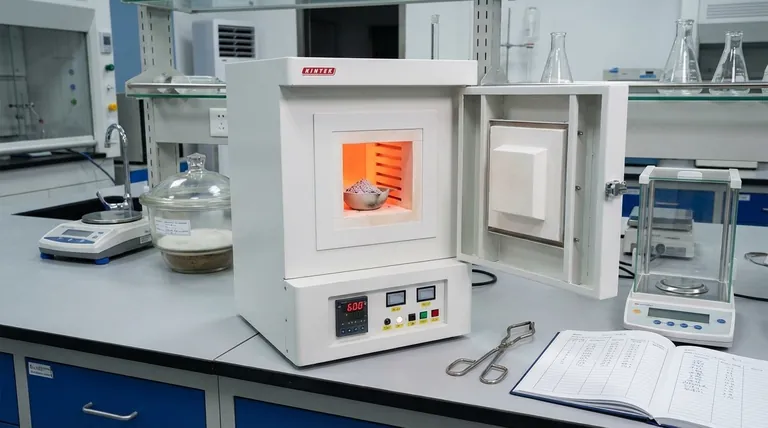At its core, the ash content test is a method for measuring the total amount of inorganic, non-combustible material within a sample. The procedure involves heating a material to a high temperature until all the organic and volatile substances have been burned away, leaving only the mineral residue, or "ash," to be weighed.
The purpose of the ash test extends beyond simply measuring minerals. It is a fundamental quality control tool used to verify a material's composition, ensure it meets product specifications, and confirm its consistency.

What 'Ash' Reveals About a Material
The ash content test is a process of separation by fire. It cleanly divides a sample into its combustible and non-combustible components, offering a clear window into its fundamental makeup.
A Measure of Inorganic Content
The resulting ash is the inorganic residue left after complete combustion. This residue typically consists of the oxides of inorganic elements present in the original sample, such as calcium, magnesium, silicon, and others.
A Proxy for Fillers and Additives
In many industries, especially plastics and polymers, inorganic materials are deliberately added as fillers or reinforcements. The ash test provides a direct measure of the total quantity of these additives, such as talc, calcium carbonate, or glass fibers.
Confirming Material Purity
An unexpectedly high or low ash content can be an immediate indicator of contamination or an issue with the raw materials. It serves as a first-line diagnostic for material purity.
The Role of Ash Content in Quality Control
For a technical professional, the ash content value is not an abstract number. It is a critical data point for ensuring product quality and performance from the raw material stage to the finished product.
Verifying Material Specifications
Many materials have a required specification for inorganic content. For example, a polymer might be specified to contain 30% glass fiber reinforcement by weight. The ash test is the primary method used to confirm this specification has been met.
Ensuring Product Consistency
Monitoring the ash content of different production batches is a simple way to ensure consistency. A deviation in ash value from one batch to the next signals an inconsistency in the manufacturing process or raw material supply chain.
Impact on Physical Properties
The amount of inorganic filler dramatically affects a material's physical properties, including its stiffness, strength, density, and cost. The ash test helps correlate the material's composition with its expected performance characteristics.
Understanding the Limitations
While powerful, the ash test is a quantitative tool with specific limitations. Understanding these is crucial for accurate interpretation.
It's a Quantitative, Not Qualitative Test
The test tells you how much inorganic material is present, but it does not identify the specific elements or compounds. A 10% ash content could be calcium carbonate, talc, or a mix of various minerals. Further analysis, such as X-ray fluorescence (XRF), is required for that.
It Assumes Complete Combustion
The accuracy of the test relies on the complete combustion of all organic material. If any organic carbon "char" remains, it will be weighed as ash, leading to an artificially high and inaccurate result.
Potential for Volatility
Some inorganic compounds can partially vaporize or decompose at the high temperatures used in the test. This can lead to a slight underestimation of the total ash content, a factor that must be considered for high-precision applications.
Applying This to Your Goal
The utility of the ash test is defined by your objective. Use it as a targeted tool to answer specific questions about your material.
- If your primary focus is process consistency: Use the ash test to monitor batch-to-batch variations and ensure your raw material supply is stable.
- If your primary focus is material verification: Use the test to confirm that the percentage of inorganic fillers in a product matches its technical data sheet.
- If your primary focus is failure analysis: An unexpected ash value in a failed part can be a red flag for contamination or incorrect material formulation, guiding further investigation.
Ultimately, the ash content test provides a simple yet powerful metric for safeguarding material quality and performance.
Summary Table:
| Aspect | What the Ash Test Reveals |
|---|---|
| Core Purpose | Measures total inorganic, non-combustible material in a sample. |
| Quality Control | Verifies material composition, purity, and batch-to-batch consistency. |
| Key Applications | Quantifies fillers (e.g., talc, glass fiber), confirms product specifications. |
| Limitations | Quantitative only (does not identify specific elements); assumes complete combustion. |
Ensure your materials meet the highest standards of quality and consistency. The ash content test is a fundamental step, and having the right equipment is crucial for accurate results. KINTEK specializes in high-quality lab furnaces and consumables designed for precise ashing procedures. Whether you're in plastics, food, pharmaceuticals, or materials science, our solutions help you verify specifications and maintain process control. Contact our experts today to find the perfect lab equipment for your quality control needs.
Visual Guide

Related Products
- 1700℃ Muffle Oven Furnace for Laboratory
- 1800℃ Muffle Oven Furnace for Laboratory
- High Temperature Muffle Oven Furnace for Laboratory Debinding and Pre Sintering
- 1400℃ Muffle Oven Furnace for Laboratory
- Laboratory Muffle Oven Furnace Bottom Lifting Muffle Furnace
People Also Ask
- What is the debinding process? A Guide to Critical Binder Removal for MIM & 3D Printing
- Why do we need to use properly some of the laboratory apparatus in the laboratory? The Foundation of Safe and Accurate Science
- What is brazing vs soldering? Choose the Right Joining Method for Strength vs. Precision
- What is the difference between a crucible and a furnace? Understanding the Heat Source and Container Partnership
- Do different liquids melt at different rates? Unlock the Science of Melting Points and Material Properties



















